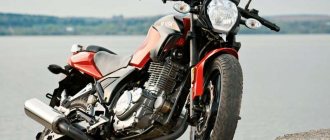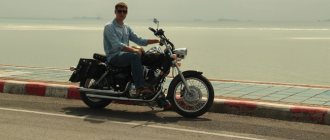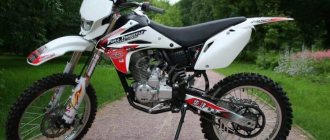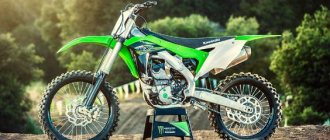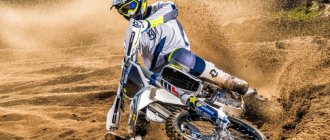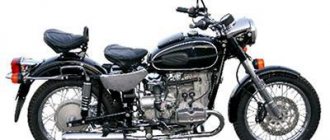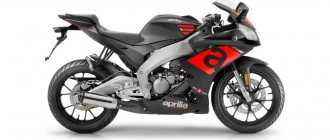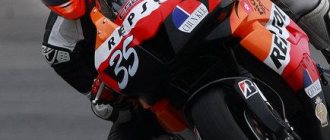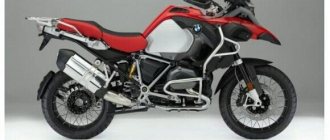Description of the motocross motorcycle KAYO K1 250 MX 21/18 (2021)
KAYO K1 250 is a legendary model of one of the most popular Chinese off-road motorcycles. It can rightfully be called the people's motorcycle. Thanks to the combination of its technical characteristics and competitive price, it has won the maximum attention and sympathy of off-road enthusiasts for two years on the market. They take their first steps off-road on it, go on forest walks and trips on it, and master the track on it. It is a comfortable, simple and reliable motorcycle. The best part is its weight (103 kg) and dimensions, which make it easy for both an adult man of average build and a fragile girl the K1 At the same time, 21/18 wheels help to overcome any obstacles, and 17 hp. on the 250th engine - quickly rush between the trees.
- Engine with a volume of 223 cc and a power of 17 hp. in combination with NIBBI PE28 carburetor;
- Durable and flexible plastic;
- Aluminum rims with tow bars;
- LED headlight;
- Variable section steering wheel FATBAR;
- The lack of progression simplifies the maintenance of an already understandable motorcycle.
And the new stylish graphics from KAYO, as always, will make you more visible on any trail!
The second day of fuss has arrived. I didn’t make Napoleonic plans - I had things to do, and besides, I didn’t fully understand how I could raise money. However, we managed to deal with this quite quickly.
I dug up a chthonic hoist of unknown vintage in the corner of the garage, struggled with hanging it on a channel (this chthon weighs a lot, and I had to lift it with outstretched arms), ran a ribbon from the tie through the frame, and with the help of this design I quite successfully hung the mot. I moved the chains to the side so as not to interfere. It turned out even better than with some homemade stand - because the motorcycle cannot be knocked down by a careless movement.
To make it clear how massive this thing is, here are some photos of the hook and chain.
And now to the motorcycle. Having hung the front end, I was able to start pulling out the feathers. This procedure did not take much time - each feather is held in place by three bolts, two 5-point hex bolts on the lower traverse and one 6-point socket on the top. The caliper and speed sensor also hang on the left feather. Naturally, he threw them off too.
I followed the oil change procedure according to some guide from YouTube. It took two five rubles and a two-liter bottle. I cut off the two-piece to put feathers in it, cut out the side of one five-piece to fill in new oil (later it will act as a canister for draining oil from the engine). The second five served to drain what was in the feathers. I drained it and closed it tightly with a lid. An open canister for draining is, of course, good, but I know myself well: somewhere at the very end of the process I would definitely step in it and stain everything around.
I was afraid that I would have to put the feathers back into the cross-arms because I forgot to remove the covers before removing them. But no, they also unscrewed the ones that were removed. A 22 key through a napkin, a couple of light sharp blows into it with a hammer - and the covers came off without any problems.
I didn’t take pictures of the process of draining the fluid and filling it with a new one, I only shot it with an action camera on a tripod. But there is nothing complicated there - I unscrewed the cap, turned the pen over into a cut two-liter bottle, and shook it. He turned the pen over and set it aside. Using a 200-cc syringe, I pumped the drained liquid from a two-room apartment to a whole five-room apartment. The left pen was filled with about 230 ml - it seemed normal. Only the oil was kind of… strange. With a suspension, or something. It wasn’t possible to convey it in the photo, but there seemed to be another faction floating there, a slightly darker shade and consistency.
I poured new fork oil from the new can into the trimmed five-piece and in two passes poured the same 230 ml into the pen with a syringe. I pumped between bays. I compared the pen with new oil and with factory oil - it became noticeably more resilient, more confident, with better feedback. In short, whatever was poured in from the factory, it is at least less viscous.
There was less oil in the right feather. And it reeked of specific rotten meat. That is, they actually poured something old in there, something that had been worked out. New oils, even of poor quality, do not smell like that. I filled in the oil, loaded the feathers - everything seemed to be the same. I put them aside for now. Using the same syringe, I pumped the excess new oil from the fiver back into the canister. Just enough for one more replacement. Next up were the steering column bearings
For ease of removal and installation, I spread all the cables and wiring to the sides. I bent one of the brackets to move the braid away.
If everything was basically normal in the front hub with grease in the bearings, then in the steering wheel it was not. See for yourself. A couple of blue spits.
I didn’t take a photo of the top hem, but there was about the same amount there. I filled it with lubricant and rolled it. I reassembled it again according to the manuals: I put on the column, tightened the nut tightly so that the bearings fit properly, after which I loosened the nut and tightened it by hand. As a result, there is no play in the column, and it moves normally, without resistance or snagging. I put on the upper console and inserted the feathers to immediately level the consoles. Well, I tightened everything up carefully.
I didn’t record how far the feathers extended from the top console at the factory. At first I aligned the lid and the plane of the console, but then raised it a little higher - so that after tightening the bolt, the upper console would compress the body of the pen, and not the lid. Although the chamfer was removed there, it shouldn’t have caused any damage, but you never know.
By the way, a question about tightening the bolts in the consoles that hold the stays. How tight should I tighten? There are also plasticine bolts, and the consoles themselves are made of some kind of silumin... I tightened them without much effort. I consulted with a friend who has a Japanese spendthrift. He said that according to the manual, the tightening of these bolts is about 24 Nm. Well, with about the same amount of force I tightened it. But if anyone has exact numbers, I would be grateful. I have a torque wrench, I just couldn’t find the values on the Internet. Only discussion forums.
I decided not to put on the front wheel yet. Instead, while the motor was suspended evenly, I decided to set the valve clearances. My probes turned out to be not quite correct - they were only 0.05 mm thinner than 0.1. Well, we'll set it to 0.1 everywhere. This is completely acceptable.
The first thing I noticed is that the BDC and TDC marks are the same. You need to realize that TDC is caught on the compression stroke. I'll double-check tomorrow, otherwise you never know. The process itself is elementary. Using a 24mm wrench (or pliers, as in my case) we unscrew the covers, use a 10mm wrench or socket to loosen the fixing nut and begin adjustment. I don’t know all the terms, so I’m describing what I saw from the factory, as everyone says everywhere, there was no gap at all - the dipstick didn’t fit at 0.05. The first time, of course, I fiddled around for quite a long time. It probably took about 15-20 minutes for both valves. I double-checked it several times, crawling up this way and that to make it more comfortable. I was training my hand, in short.
You need to realize that TDC is caught on the compression stroke. I'll double-check tomorrow, otherwise you never know. The process itself is elementary. Using a 24mm wrench (or pliers, as in my case) we unscrew the covers, use a 10mm wrench or socket to loosen the fixing nut and begin adjustment. I don’t know all the terms, so I’m describing what I saw from the factory, as everyone says everywhere, there was no gap at all - the dipstick didn’t fit at 0.05. The first time, of course, I fiddled around for quite a long time. It probably took about 15-20 minutes for both valves. I double-checked it several times, crawling up this way and that to make it more comfortable. I was training my hand, in short.
To access the intake valve cover, you need to unscrew the two engine bracket bolts from the frame and loosen the bolt on the engine itself, and then simply move the bracket to the side.
Tomorrow I'll check if I did everything correctly and if I didn't confuse TDC with BDC. And you never know...
By the way, I found the trunk. There was no need to worry in the last post . However, the manufacturer did not provide a hole in the plastic for it. You'll have to drill.
There was no need to worry in the last post . However, the manufacturer did not provide a hole in the plastic for it. You'll have to drill.
Tomorrow, according to the plan, we will finally free the motor from the transport frame, install the front wheel, assemble the rear suspension, install the steering wheel and separate the wires and cables, change the oil. In short, get as close as possible to the first departure already. True, now there seems to be nowhere to rush - the rains have started to rain...
Characteristics of the motocross motorcycle KAYO K1 250 MX 21/18 (2021)
| Model year | 2021 |
| Engine | single cylinder, 4 stroke (YX166FMM) |
| Engine capacity | 223 cc |
| Power | 16.5 hp |
| Transmission | 5-speed 1-N-2-3-4-5 |
| Cooling | air |
| Fuel supply system | carburetor NIBBI PE28 |
| Front suspension | telescopic, inverted type 800 mm, non-adjustable |
| Rear suspension | backpack-type monoshock absorber, 360 mm, non-adjustable |
| Front brake | disc hydraulic |
| Rear brake | disc hydraulic |
| Wheel size | 21/18 |
| Base | 1340 mm |
| Seat height | 880 mm |
| Weight | 103 kg |
| Tank capacity | 6.7 l |
| Additionally | LED optics, Fatbar variable-section steering wheel, rear trunk. |
| Dimensions (LxWxH), mm | 2010x840x1160 mm |
CHINESE ENDURO MOTORCYCLES KAYO. COMPARISON OF KAYO K2, KAYO T2 AND KAYO T4 MODELS.
A LITTLE EARLIER.
Just recently, enduro motorcycles from the Middle Kingdom were looked at askance. Like, what kind of joke is this, how can you even drive this, let alone participate in competitions. Now the situation has changed, if not radically, then radically. Cross-country motorcycles of many Chinese brands have reached a respectable level. Be it QINGQI, BSE, ASIA WING…. So the KAYO company, thanks to cooperation with Honda China, investments in advanced production technologies, a developed quality control system, and, last but not least, the right, correct vector of development, has reached this milestone. The KAYO company itself (Jinyun Kayo Motor Machinery Co.Ltd.) began developing high-quality and inexpensive pit bikes not so long ago - since 1999. But now KAYO is a high-tech enterprise. At the moment, the production of more than 50 different types of motorcycles has been established - motocross motorcycles, pit bikes and ATVs.
KAYO is known for its quality far beyond China and is represented on all continents, with official distributors in more than 20 countries around the world. Just a few years ago we had our eye on KAYO off-road motorcycles, and pit bikes and ATVs from this company have been selling quite successfully in Ukraine for many years. Of course, product quality is at the forefront, but at that time the price of motorcycles stopped us. Having slightly revised its concept, our company is trying to present on the Ukrainian market both inexpensive, budget motor vehicles, as well as motorcycles, ATVs and electric bicycles of a higher price segment. We use the same rule when purchasing spare parts for the products we represent. The buyer has the right to choose for himself, buy spare parts for a motorcycle at a price he can afford, or choose something better, but much more expensive. So, for example, spare parts from QINGQI will cost 1.5, or even 2-3 times more expensive than their counterparts from nameless factories. Of course, such spare parts (analogues) still need to be selected so as not to bring outright rubbish, and the sellers of such companies require the purchase of each item in at least hundreds of units. Then, for example, original KAIO spare parts can be purchased in a minimum quantity of 5-10 pieces.
Let's get back to motorcycles. In 2016, at an exhibition in Guangzhou, we talked with the managers of KAYO about possible cooperation. Unfortunately, the start of our joint activities had to be postponed, since we decided to begin by restructuring our work from the BUSINESS - BUSINESS position to the new BUSINESS - CLIENT basis. Many will understand that this is a rather difficult period that requires not only time...
We finally came to work together with KAIO at the end of 2022, but then the company itself made internal changes, and as a result, our first order of motorcycles was put into production only 3 months later. Or maybe that's for the best. Since the new versions of motorcycles produced in 2022, with a reinforced supporting frame, updated instrument panels, and larger rear sprockets, will certainly appeal (in fact, they already have) to the taste of our motorcycle enthusiasts. Let us immediately note that this is only the beginning of cooperation with the KAYO company, and we have far-reaching plans.
ABOUT MOTORCYCLES.
So, on the agenda we have 3 KAYO motorcycles - K2, T2 and T4, which our company managed to receive by the time of writing this article. The engines on all three motorcycles are of the same type - single-cylinder, air-cooled, two-valve, overhead, without a balancing shaft, type CB-250, with an engine capacity of 223 cc.
True, the K2 has a YX250 166FMM engine, and the T2 and T4 have a ZS250 169FMM. I consider it necessary to clarify that the piston in the engines is the same. The piston diameter is 65.5, its stroke is 66.2. Lead-gel batteries 12V, 6Ah are installed. Next I will describe the motorcycles in the form in which we received them. Unfortunately, to answer the questions - “what is the difference between T2 2016 and T2 2018?” — we can’t, simply because we don’t know the equipment of motorcycles (this, by the way, applies to all KAIO motorcycles) of previous years of production. The gearbox is manual, 5-speed, with an international gear shift pattern.
The drive chain is 520, the ratio of the drive and rear sprocket is 13T-45T. Fuel tanks are plastic. In this and subsequent deliveries, LED headlight lamps are installed in motorcycles. The brakes are front and rear disc, the starting system provides for starting the engine using both a kickstarter and an electric starter.
MOTORCYCLE KAYO K2-250.
This is a full-fledged enduro developed by KAYO, which until recently had been known in the rest of the motorcycle community for quite some time as the K1 model. In 2022, the company modernized the motorcycle, strengthening the supporting frame, and adding a full-fledged speedometer, instead of the hour meter on the K1, however, I could be wrong - it is likely that from year to year the Chinese comrades improved the motorcycles and by the beginning of 2022 the K1 already had quite a lot differences from the 2014 motorcycle, so they decided to upgrade the name to the next level.
Just a few months later, the KAYO K1 model was discontinued, at least our order was refused, and at the moment it was even removed from the company’s official website. The main features of the motorcycle are the absence of a rear trunk and passenger footrests. Those. the motorcycle is positioned as a single-seater. There is no link progression on the K2; the rear monoshock has adjustable spring preload. The wheels on the motorcycle are installed: front - 21, rear - 18. The front wheel has an aluminum alloy rim, size 2.15x18, a tire size 80/100-21 is installed, the rear wheel also has an aluminum alloy rim, size 2.15x18 , tire size 110/90-18 installed.
Both the front and rear tires are equipped with tube tires, with an off-road tread, manufactured by YUANXING. Tow bars are installed on both wheels to prevent the rubber from turning when the pressure in the chamber decreases. Experts say it is a very useful thing when driving through sand and swamps. A short video about the differences between K2 and T2.
MOTORCYCLE KAYO T2-250.
The main difference between the T2 and T4 motorcycles from the K2 is the presence of a rear trunk and passenger footrests, as well as the presence of Link progression
on the rear wheel arm. I think it would be worth repeating that the T series models have an engine manufactured by ZONGSHEN. More about T2 - we get this model in two versions - on wheels 21-18 and on 19-16. On the T2 21-18 model, the seat height is 880 mm, ground clearance is 280. With wheels of smaller diameter, these figures are 840 and 250, respectively. Also, the rims of wheels of sizes 21-18 are light alloy, and those of 19-16 are metal, the magnet will stick to them, bless you! The remaining characteristics of the T2 motorcycles are completely identical. The difference in price is 1600 hryvnia; it’s up to you to decide who needs which motorcycle.
The T2 used to have a regular metal enduro handlebar. Now this only remains on K2. The T2 now has an “adult” aluminum steering wheel with a variable section. Also different from the K2 is the rear shock absorber - it is on the T2 with gas pumping and is 65 mm longer. The front shock absorbers on K2 and T2 are the same, 800 mm long. Front suspension travel 215 mm. Rear suspension travel on T2 is 95 mm. The fuel tank volume has been expanded to a capacity of 9.5 liters.
MOTORCYCLE KAYO T4-250.
Differences from T2 – completely different suspension. The T4 features lighter, stronger aluminum alloy wheel rims and higher-quality heavy-duty aluminum wheel hubs.
The rims are painted black. Although the rim and tire sizes are the same, the T4 is equipped with “evil” KENDA tires. Front shock absorbers are inverted type, 880 mm long (6 mm larger in diameter), manufactured by Taiwanese FAST ACE with adjustable spring return and compression. Rear suspension on a progression link with a 450 mm shock absorber, also manufactured by FAST ACE, with gas pumping, with adjustments for the degree of damping, rebound and spring preload. The front brake disc is 30 mm wider than on the T2, the rear brake disc is 20 mm wider. The rear disc brakes, unlike the T2, are equipped with a single-piston caliper. The rear swingarm, unlike the metal one on the T2 and K2, is light alloy and 40 mm longer. A short video about the differences between T2 and T4.
The seat height, compared to the T2, is increased by 80 mm, the dry weight is 7 kg more, and the ground clearance is 70 mm wider.
That's all for now. More detailed technical characteristics of motorcycles and their prices - https://skybike.com.ua/index.php?route=product/category&path=49.
You can buy enduro motorcycles KAYO K2, T2, T4 inexpensively from the supplier’s warehouse in Odessa by contacting our managers 050-492-66-07. Also, by phone 050-492-66-18 you can find out where you can buy KAIO motorcycles in Ukraine in the place closest to you. Original spare parts for KAIO motorcycles are also available.
Interrobang SKYBIKE.
Work on mistakes
The efforts that the Chinese made before releasing the K6 onto the world market led to the fact that this motorcycle became a real competitor to the ancient Japanese and European motorcycle junk. Let me explain to skeptical readers: when choosing between the furry Djebel, XR and the like, today many potential buyers prefer a new, albeit Asian, motorcycle. With a conditionally equal price, the former have quality of workmanship on their side (although for a 20-year-old off-road classic, these are rather memories of past achievements) and...perhaps that’s all.
It seems to me that the K6 has significantly more positive qualities. First of all, these motorcycles are new! With the privileges corresponding to this status. Such as a full warranty and a new, pristine title. Secondly, there are no problems finding spare parts and consumables! The official Russian distributor of the Kayo brand, the Rolling Moto company, values its reputation and keeps a sufficient number of necessary parts in its warehouse. Thirdly, with very similar power output, the K6 looks much better and more modern.
Of course, the main pressing issue is, of course, the reliability of the new model. Despite some sloppiness in manufacturing and assembly, the K6 showed its best side. Before my eyes, at the off-road school, 3 brand new Kayos appeared. And after half a year of savage use, the students only bent the bolts of the steering wheel stop, broke the contact - the “frog” on the clutch lever, and inexplicably burned the charging relay on one of the motorcycles. Everything else is traditional for off-road motorcycles - expenses. Rubber, handlebars, chains, sprockets and technical fluids.
The plastic, like on cheap Chinese ones, does not break, but only bends gracefully, the wheels, when used in the forest, do not wrinkle like an empty tin can, and the wheel spokes, if you pay due attention to their tension, do not leave their rightful places on the rim. Of the obvious disadvantages, I would like to note plasticine handlebars that bend with every fall and disgusting drive chains that stretch like a wet clothesline after every workout/ride.

